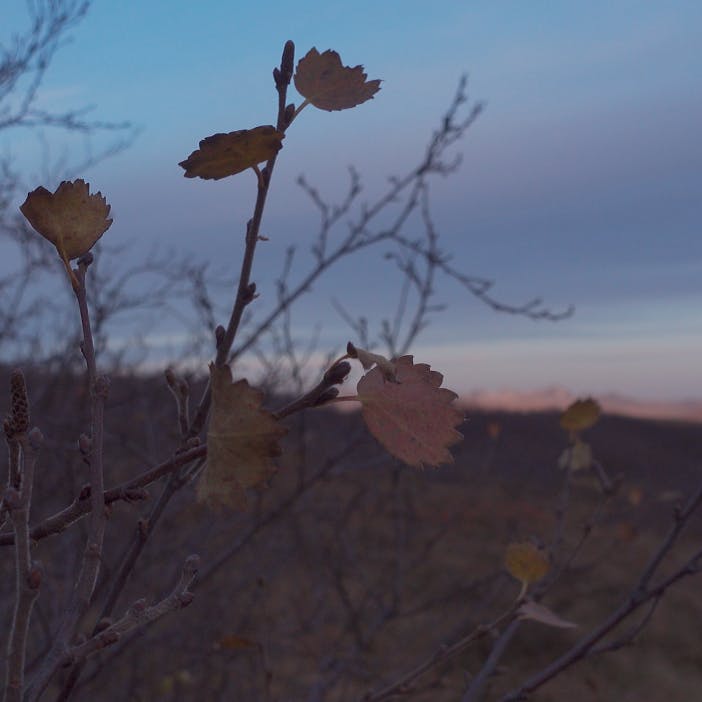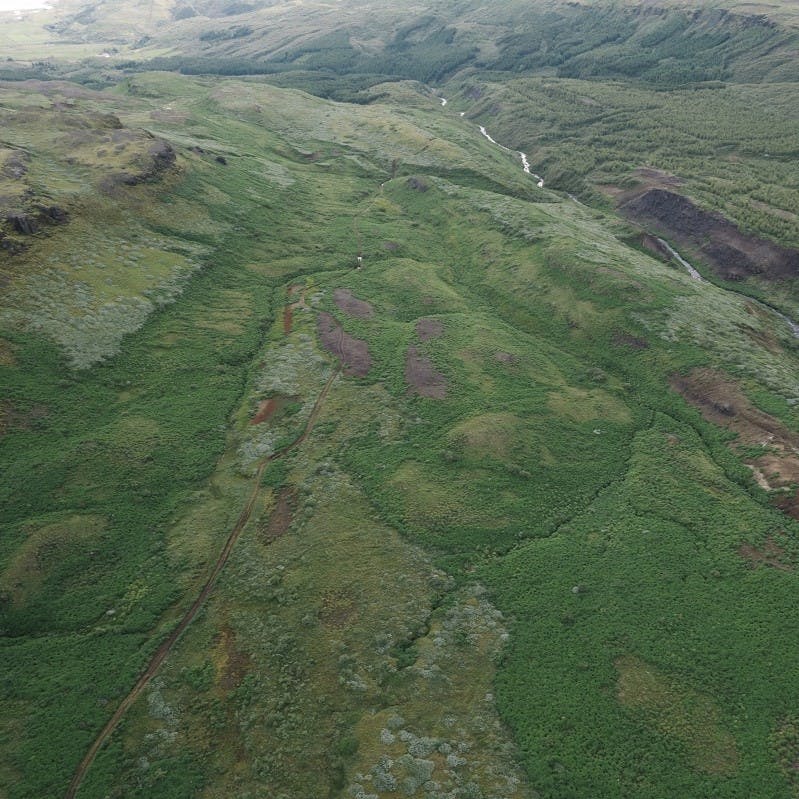- Management Plan
- Trees planted: 305,816
- Status: In Progress
Iceland is known for its vast open landscapes shaped by massive volcanos and expansive glaciers. Native birchwoods, the only woodland type to form in Iceland, are also an important part of the landscape. They offer food and shelter for biodiversity, help stabilise soil, provide wind breaks, and sequester carbon. At one point, it is thought that 25-40% of Iceland was covered in birchwoods. Now, it's just 1%. This project, in partnership with the Iceland Forest Service and private landowners Kári and Ragnheiður, aims to restore birchwoods to an area about 120km east of Reykjavik in the southern uplands of Iceland, where natural succession could take centuries or even millennia.
Project Timeline
Spring & Summer 2025
Planting of 30,000 downy birch and 2,000 alder (black and grey alder) on 25 ha of privately owned land at Galtalækur, southwest Iceland. To see 360º images and photos, expand the map's sidebar and select the 'Planting Area 2025' polygon.
Spring & Summer 2024
1,000 tea leaved willow, 1,000 aspen and 30,000 birch planted in 25 ha of privately owned land.
The Ecosystem
Tree Species
We plant downy birch (Betula pubescens) as the dominant species because it is an excellent pioneer, which will make the conditions more favourable for other native tree species to thrive. Tea leaved willow (Salix phylicifolia) is incredibly efficient at natural dispersal so it is only a small proportion of our planting to create seed islands where willow is absent from the landscape. Aspen (Populus tremula) is similarly efficient at self propagation. The final native species found in these birch woodlands is rowan but this will survive much better if planted a few years after the other species once conditions are more favourable.
Priority Species
Redpoll (Acanthis flammea), redwing (Turdus iliacus), snipe (Gallinago gallinago) and ptarmigan (Lagopus muta).

Learn More About the Context Behind this Project
A History of Decline
Reversing centuries of degradation
At the time of human settlement almost 1,150 years ago, Iceland had a forest cover of between 25% to 40%. By the mid 20th century, it is thought to have been reduced to less than 1% of the total land area, perhaps even less than 0.5%.
Huge swathes of forest were cleared by the first settlers of the island, who used the wood for fuel, ships and houses, and then also cleared forest to make room for sheep grazing.
For the last few decades, tree planting projects and afforestation grants have got underway, and today, native woodland cover stands at around 1%. The Iceland government aims to increase that number to 5% in the next 50 years.

A Lone Woodland
What makes the ecosystem special?
Iceland birchwoods are unusual in that they are the only type of native woodland to form in Iceland. All other woodland types are comprised of non-native species, such as spruce and larch. Birchwoods are comprised predominantly of a single species - downy birch. Rowan and tea-leaved willow add some diversity to the woodland, as well as aspen, an extremely rare tree in Iceland that exists in only 6 wild locations. Birchwoods are also not particularly tall, with trees reaching roughly 15m in height in sheltered valleys. Towards the coast and on exposed sites, birchwoods transition to birch and willow scrub, and at high elevations to willow tundra.
Birchwoods provide important habitat for wildlife, particularly birdlife, such as wrens, redwings, and redpolls. They are also important for capturing carbon and as a windbreak. Iceland is well known for its wind, which, combined with its volcanic activity, is a recipe for disastrous sand and ash storms that blow unimpeded across much of the landscape. Birchwoods can help stabilise soils and act as a much-needed barrier against the storms.

The Threats
Deforestation
When settlers arrived in Iceland, they began harvesting birchwoods for fuel, building material and livestock fodder. The most important forest produce at the time was charcoal, needed to smelt iron and make iron tools. Birchwoods were also cut down to create fields and grazing land for sheep, which were farmed for wool and later for food.
Overgrazing
Once the trees were cut down, woodland cover continued to decline due to overgrazing by sheep. Sheep roam freely across the landscape and can browse naturally generating birch trees. If you want to keep sheep off your land in Iceland, it is your responsibility to keep them out by building a fence. Today, natural regeneration failure due to livestock grazing is the principle cause of deforestation.

More Threats
Soil erosion
Iceland has been described as the most eroded land in Europe, possibly the world. As the woodlands and vegetation disappeared, soil was left exposed to the hash Icelandic climate. Over time, this has left poor quality substrate and little in the way of nutrients for trees to grow across many areas in Iceland. Considerable efforts have been put into halting and reversing this trend in the last century, led by the Soil Conservation Service of Iceland.
A changing climate
A cooling climate, volcanic eruptions and other types of disturbance are sometimes cited as causes for the decline in woodland in Iceland, but do not explain the entire picture. Cooling temperatures might have lowered the tree line, as the higher altitude areas became more inhospitable to trees, but do not explain the disappearance of birchwoods in the lowlands. Natural disturbances, such as volcanic eruptions, are sporadic and restricted to particular sites, so not do explain the widespread deforestation across the country.

Skridhufell Planting Area
The initial planting site allocated for this project was in the west of the country in an area called Bakkakotsháls, translated to Bankcroft Hill. However, planting at this location was suspended due to a complaint received about an access road to the site being repaired.
The Icelandic Forestry Service has reassigned this project to an area located in Skeiða- og Gnúpverjahreppur in the south of Iceland. The planting area is situated just south of Selklettar mountain besides a hill of 240m in elevation named Skridhufell. In 2023, we also planted on the opposite side of the valley. The area is picturesque with a winding river running through it and a waterfall close by. Wildlife that inhibits the area include the native arctic fox and a variety of birdlife. The area also contains patches of eroded soil and lupin - a rapid spreading invasive plant. As this plant has soil improving qualities and is the topic of debate around Iceland, we've made a special video on this divisive issue (see below).
If you'd like dig deeper into this component of the project, see our management plan.

Galtalækur planting area
Private landowners, Kári and Ragnheiður, are overseeing our tree planting on their 100 ha property between 2024-2027. The land was once covered in vast forests containing rich soil, but has suffered degradation due to erosion and land use. The initial degradation of the land happened after a huge sandstorm swept through the area in 1882. Since then, despite the area being fenced off to browsing pressure from sheep, not much else has been done except for lupine seeding and small batches of birch planting to restore the forests to their former glory.
In preparation for each planting season, the soil will be prepared for planting by using organic fertilisers and seeds, in collaboration with the Soil Conservation Agency (Landgræðslan) in Gunnarsholt. A especially prepared seed mixture for landowners with barren lands will help reduce erosion rates and improve conditions for local plants.
In addition to planting birch, we will plant aspen, alder, black cottonwood and willow to avoid uniformity and increase the likelihood of success.
For further information, see this Management Plan.

Future Ambitions
Our long-term plans are to work towards wider restoration objectives in Iceland. The next step we've taken is to set up a wetland restoration project in the vast freshwater ecosystems of Mýrar, West Iceland.
Where do you sit on the lupin issue?
Here is a take on the divisive invasive plant in Iceland. Check it out and let us know your opinion!
YouTube Playlist
Check out this playlist to follow this project's story on YouTube.
Sources & further reading

- “Restoration of birch woodlands in Iceland” - Aradóttir, Á. and Throstur, E. (2005)
- “Soil carbon status after vegetation restoration in South West Iceland” - Nyirenda, H. (2020)